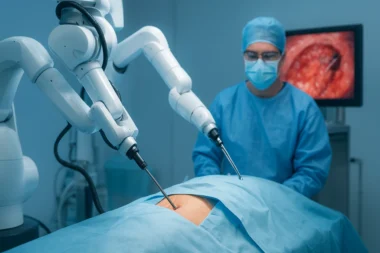Introduction
Wearable technology in healthcare refers to devices or accessories worn on the body, typically smartwatches, fitness trackers, smart clothing, or medical devices. These wearable devices have sensors, processors, and wireless connectivity, allowing them to collect and transmit data about the user’s health and well-being.
Data collection and transmission
Data collection and transmission in wearable technology involve several components and processes to ensure accurate and reliable information. Let’s explore how data is collected and transmitted in wearable technology in detail:
Sensor Data Collection: Wearable devices incorporate various sensors to collect health parameters and activity data. Some standard sensors used in wearable technology include:
- Photoplethysmography (PPG) sensors measure heart rate, blood oxygen levels, and pulse waveform analysis.
- Accelerometers and gyroscopes capture motion and activity data, including step count, distance traveled, and posture analysis.
- Temperature sensors: Monitor body temperature and detect fever or thermal changes.
- Electrodermal activity (EDA) sensors measure skin conductance, indicating stress levels or emotional arousal.
- Electrocardiogram (ECG) sensors capture the heart’s electrical activity and detect arrhythmias or abnormalities.
These sensors continuously collect data from the wearer’s body, generating raw sensor data.
Data Processing and Feature Extraction: The raw sensor data collected from wearable sensors undergoes processing and feature extraction to derive meaningful insights. Signal processing techniques such as noise reduction, filtering, and feature extraction algorithms are applied to clean and extract relevant information from the raw data. For example, noise removal techniques eliminate unwanted artifacts, filtering algorithms isolate specific frequency bands, and feature extraction algorithms identify patterns or characteristics in the data.
On-Device Processing or Companion Apps: After the data is processed and relevant features are extracted, it can be handled in one of two ways:
- On-Device Processing: Some wearable devices have built-in processors capable of performing data analysis and feature extraction directly on the device. This allows for real-time insights and immediate feedback for the wearer.
- Companion Apps and Cloud-Based Platforms: Other wearables transmit the processed data to companion apps or cloud-based platforms for further analysis. The wearable device sends the data wirelessly to a smartphone, tablet, or computer, where specialized software or applications process and interpret the data. These apps may employ algorithms, machine learning models, or artificial intelligence techniques to derive insights from the collected data.
Wireless Data Transmission: Wearable devices utilize wireless connectivity options to transmit the data to external devices or cloud platforms once the data is processed and ready for transmission. The most commonly used wireless communication technologies include:
- Bluetooth: Wearables often use Bluetooth Low Energy (BLE) to establish connections with smartphones, tablets, or other devices within proximity. BLE enables efficient and low-power data transmission.
- Wi-Fi: Some wearables can connect to Wi-Fi networks, allowing for longer-range data transmission and synchronization with cloud-based platforms.
- Cellular Networks: Advanced wearable devices with cellular capabilities can transmit data directly over cellular networks, enabling remote monitoring and communication without relying on other devices.
Data Security and Privacy: As wearable devices collect and transmit sensitive health data, ensuring data security and privacy is paramount. Encryption techniques and secure communication protocols (e.g., Transport Layer Security, SSL/TLS) safeguard the transmitted data from unauthorized access or interception. Additionally, wearables should adhere to privacy regulations and data protection policies to maintain the confidentiality of user information.
Case study
- Objective: The objective of the case study was to evaluate the impact of wearable technology on the rehabilitation process for patients recovering from lower limb injuries. The focus was on enhancing mobility, gait analysis, and tracking progress over time.
- Participants: A group of 30 patients aged between 30 and 60 with lower limb injuries were selected for the study. The participants had varying degrees of mobility impairment due to fractures, ligament tears, or post-surgical recovery.
- Intervention: The participants were provided with wearable devices consisting of motion sensors and accelerometers to be worn on their lower limbs. These devices captured real-time data on movement, gait parameters, and exercise compliance.
- Data Collection and Analysis: The wearable devices collected data on metrics such as step count, stride length, gait symmetry, and duration of physical activity. The collected data were synchronized with a mobile app, allowing patients and healthcare professionals to monitor progress and adherence to prescribed rehabilitation exercises. The data analysis involved comparing pre- and post-intervention measurements to assess the effectiveness of the wearable technology.
- Results: The results of the case study demonstrated several positive outcomes:
- Improved Mobility: Participants’ step counts and stride length increased, indicating a significant improvement in mobility. The wearable devices encouraged patients to improve their daily physical activity levels and track their progress, improving overall mobility.
- Enhanced Gait Analysis: The wearable technology enabled detailed gait analysis, highlighting abnormalities or asymmetries in the participants’ walking patterns. This data allowed healthcare professionals to customize rehabilitation plans and target specific areas for improvement.
- Personalized Interventions: With real-time data, healthcare professionals could provide personalized interventions and timely patient feedback. This facilitated a proactive approach to rehabilitation and enabled adjustments in treatment plans based on individual progress.
- Increased Patient Engagement: Wearable technology motivated patients to participate in their rehabilitation journey actively. The ability to visualize their progress and receive real-time feedback fostered a sense of empowerment and encouraged adherence to prescribed exercises.
Conclusion
Wearable technology has revolutionized the way healthcare data is collected and transmitted. By incorporating sensors, data processing algorithms, and wireless connectivity, wearable devices enable continuous monitoring of health parameters and provide valuable insights for personalized care. The seamless collection and transmission of data in real-time empowers individuals and healthcare professionals to make informed decisions and take proactive measures to improve health outcomes. However, it is crucial to prioritize data security and privacy to ensure the confidentiality of sensitive health information.



